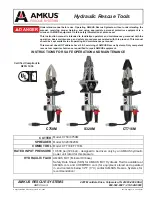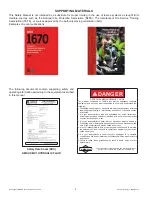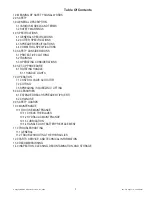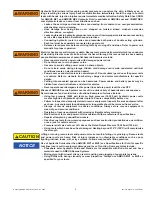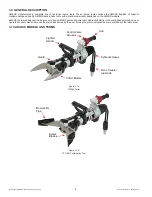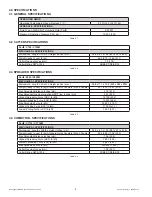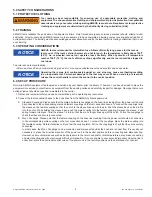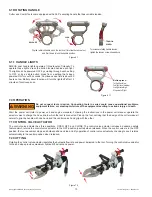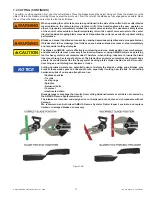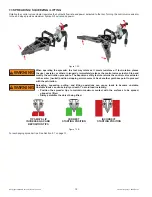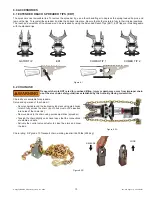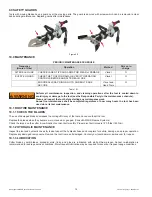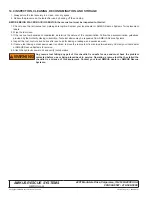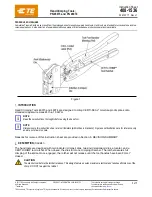
©Copyright AMKUS Rescue Systems, Inc. 2020
LAL-001 August 11, 2020 Rev01
5
WARNING
Hydraulic
fl
uid (mineral oil) escaping under pressure can puncture the skin, in
fi
ltrate eyes, or
lungs resulting in serious injury. Seek medical attention immediately. Avoid the urge to contain
leaks with hands. Injection injuries require immediate medical attention. Safety Data Sheet (SDS)
for AMKUS MV1 and AMKUS MV0 Hydraulic Fluid is available at AMKUS.com and CHEMTREC.
com Hydraulic leaks can occur from situations such as:
• Leaks at hose crimps and connections can develop from constant use, over-pressurization,
side-loading, or mis-crimping.
• Hose damage from being driven over, stepped on, twisted, kinked, crushed, excessive
vibration, abuse, or neglect.
• Leaks and breaks in hydraulic components can occur from improper maintenance or exceeding
service life expectations. Establish sound practices.
• Connecting hydraulic tools in series can pressurize both sides of double acting cylinders.
Each tool must be separately connected to a power unit.
• Release stored pressure before servicing tools by moving o
ff
end stops. Refer to power unit
manuals for proper operation.
WARNING
Electric shock can result in injury or death. Rescue tools are made from metal which is a conductor
of electricity. Electric current can
fl
ow from the hazard through the rescue tool to shock nearby
people. Maintain awareness of potential hazards. Examples include:
• Never operate electric power units with damaged power cords.
• Do not drive over or crush power cords.
• Use care to avoid cutting power cords on sharp objects.
• Do not strain cords during storage. Hidden cord damage can remain undetected until wet
conditions create an electrocution hazard.
• Power sources and electronics are not waterproof. Do not submerge or douse the power units
or controls. Refer to manuals from battery, charger, and motor manufacturers for speci
fi
c
details.
• Cutting into concealed spaces can be hazardous. Power cables and battery packs may be
hidden from view in structures and electric vehicles.
• Never operate near damaged electric power lines before power is veri
fi
ed as OFF
WARNING
Misuse of AMKUS Rescue Systems can result in a wide variety of hazards and consequences.
Remain aware of and avoid misuse situations. Examples of misuse include:
• Using low pressure (5000 psi) tools on high pressure (10,500 psi) hydraulic power units
creates high risk of hydraulic cylinder rupture. Ensure compatibility before use.
• Failure to inspect and properly maintain rescue equipment. Inspect all rescue equipment after
each use. Any equipment found damaged or inoperable should be removed from service.
• Storage of rescue equipment in adverse conditions. Always store rescue equipment in
clean,dry, and secure conditions.
• Operation of rescue equipment with missing or illegible safety markings
• Modi
fi
cation of tools and power units inconsistent with manufacturer’s speci
fi
cations
• Repairs attempted by unquali
fi
ed workers.
• Use of rescue tools for non-rescue purposes such as construction, production use, demolition,
or as a jack for vehicle service.
• Pressure relief valve set over +5% above the Rated Output Pressure 10,500 psi (724 bar)
• Using tools which have been heat damaged. Heating beyond 212°F (100°C) will compromise
the strength.
CAUTION
Lifting or moving rescue tools and power units can result in falling or spine injury. Rescue tools
and power units are heavy. Risk of injury increases in unfavorable conditions such as poor
lighting, inclines, loose, wet, or icy surfaces. Follow accepted safe lifting practices.
NOTICE
Use of hydraulic
fl
uids other than AMKUS MV1 or MV0 (see Speci
fi
cations for
fl
uid for speci
fi
c
tool lines) can result in equipment damage and loss of function. Some examples include:
• Phosphate ester hydraulic
fl
uids and blends are incompatible with Buna-N seal and hose
materials used in AMKUS Rescue Systems
• Mixing glycol with mineral oils can result in gelling and plugging of pump inlet screens
• Using
fl
uids with wrong viscosity or wear properties. Always use AMKUS MV1 or MV0 as
speci
fi
ed for your tools.

